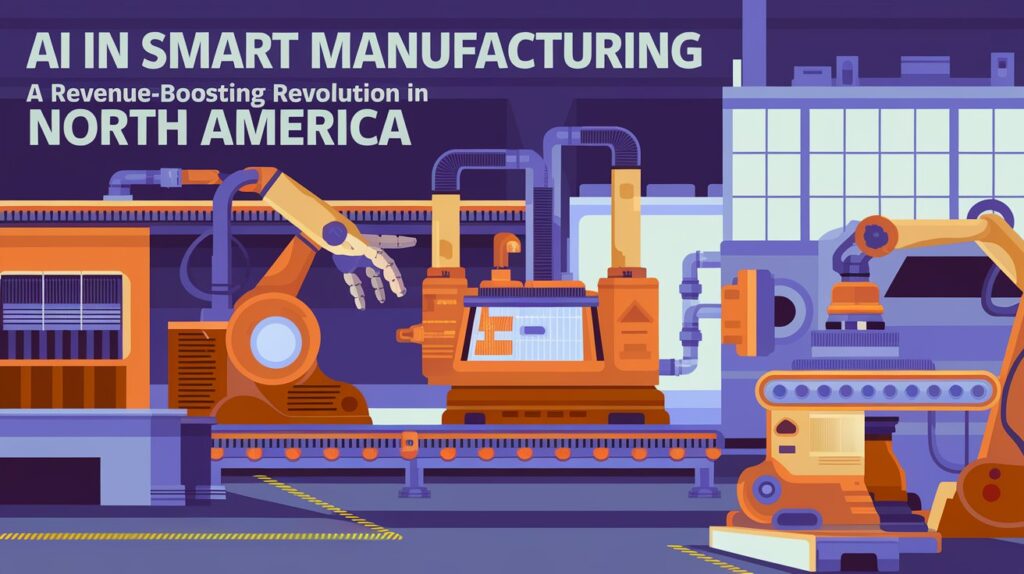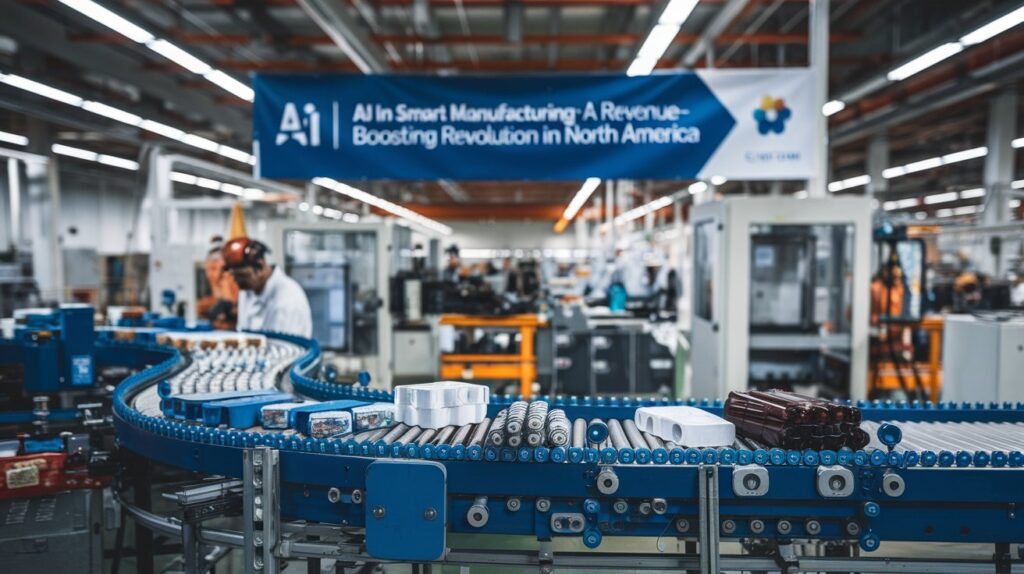The Fourth Industrial Revolution, also known as Industry 4.0, is transforming traditional manufacturing processes through the integration of cutting-edge technologies such as the Internet of Things (IoT), automation, and, most notably, Artificial Intelligence (AI). In North America, the manufacturing sector has been quick to adopt AI-driven solutions as companies seek to enhance efficiency, optimize production, reduce costs, and ultimately increase revenue.
Get More Information:
https://www.marketsandmarkets.com/pdfdownloadNew.asp?id=105448439

AI-powered smart manufacturing represents a significant shift in how factories operate, manage supply chains, and ensure product quality. This blog explores how AI is revolutionizing smart manufacturing in North America and the ways in which it is driving revenue growth across the industry.
What is Smart Manufacturing?
Smart manufacturing involves the use of digital technologies such as AI, machine learning (ML), IoT, and big data analytics to create an interconnected and intelligent production environment. In a smart factory, AI can be leveraged to predict equipment failures, optimize production schedules, enhance product quality, and make real-time decisions to streamline operations.
AI plays a crucial role in automating complex tasks, identifying patterns in production data, and providing actionable insights to improve decision-making. By utilizing AI, manufacturers can make data-driven decisions to achieve greater efficiency and productivity, which directly impacts their bottom line.
The Impact of AI on Revenue Growth in North American Manufacturing
AI is a game-changer for the North American manufacturing industry, providing numerous opportunities to increase revenue. Here’s how AI is reshaping the landscape and helping manufacturers maximize profits:
1. Optimized Production Processes
AI allows manufacturers to optimize production workflows by analyzing large datasets in real-time, identifying bottlenecks, and recommending adjustments to improve efficiency. AI-driven systems can predict machine downtime, optimize production schedules, and even automate certain tasks, reducing errors and increasing throughput.
For example, AI-powered predictive maintenance systems analyze data from sensors and machinery to forecast potential equipment failures before they occur. This minimizes unplanned downtime, reduces maintenance costs, and ensures smooth production—ultimately increasing revenue by keeping operations running efficiently.
2. Enhanced Supply Chain Management
A major benefit of AI in smart manufacturing is its ability to optimize supply chain operations. AI algorithms can analyze patterns in demand, inventory levels, and logistics to forecast supply chain disruptions, adjust procurement schedules, and streamline distribution networks. This level of efficiency reduces operational costs and improves customer satisfaction by ensuring timely delivery of products.
AI can also help manufacturers better manage raw material purchases and production schedules, reducing waste and avoiding stock shortages. By optimizing supply chain management, companies can significantly improve their profit margins and reduce excess costs, leading to higher overall revenue.
3. Improved Quality Control
AI-powered vision systems and machine learning models have revolutionized quality control in manufacturing. These systems can inspect products at every stage of production, identifying defects and inconsistencies that would be difficult or impossible for human workers to detect. AI can analyze images, sensor data, and other input to assess product quality in real-time.
By catching defects early and improving the overall quality of goods, AI ensures that manufacturers can reduce the number of faulty products that reach the market. This not only saves costs on recalls and repairs but also enhances brand reputation and customer loyalty, leading to increased revenue from repeat business.
4. Customized and Flexible Production
AI allows manufacturers to move from mass production models to more flexible, on-demand production strategies. By analyzing customer data and trends, AI systems can help manufacturers tailor products to specific customer needs and preferences, allowing for greater customization and smaller production runs.
This level of flexibility enables manufacturers to offer personalized products, increasing customer satisfaction and allowing businesses to charge premium prices for customized goods. AI also enables quick adjustments to production lines, reducing lead times and responding faster to market changes, which helps manufacturers stay competitive and boost sales.
5. Cost Reduction Through Automation
AI and robotics are central to the automation of manufacturing processes. By automating repetitive and labor-intensive tasks, manufacturers can reduce labor costs and improve overall productivity. AI-powered robots and autonomous machines can work around the clock, boosting production without the need for breaks, thus maximizing output and increasing revenue.
Furthermore, AI-driven automation helps reduce human error, which can be costly in terms of both time and materials. With AI managing routine tasks and freeing up human workers for higher-level, creative decision-making roles, manufacturers can optimize labor resources and cut operational costs, directly contributing to revenue growth.
6. Predictive Analytics for Demand Forecasting
AI’s ability to process vast amounts of data quickly and accurately makes it invaluable for demand forecasting. By analyzing historical sales data, market trends, and even external factors such as weather or economic shifts, AI systems can provide highly accurate forecasts of future demand.
This enables manufacturers to produce the right quantity of products at the right time, reducing the risk of overproduction or stock shortages. Better demand forecasting not only reduces waste and inventory costs but also helps manufacturers capture more sales by ensuring they have the right products available when customers need them.
Case Studies: AI-Driven Revenue Growth in North America

Several North American manufacturing companies have already reaped the benefits of implementing AI in their operations:
General Electric (GE)
GE has implemented AI-driven predictive maintenance across its manufacturing facilities, leveraging data analytics to optimize equipment performance and reduce downtime. By using AI to predict machine failures before they occur, GE has saved millions in maintenance costs and avoided costly production delays, directly boosting profitability.
Tesla
Tesla is a prime example of a North American manufacturer using AI to streamline production and enhance product quality. The company uses AI-powered robots and machine learning algorithms to optimize the assembly line for its electric vehicles. Tesla’s AI-driven automation has allowed it to scale production efficiently while maintaining high-quality standards, contributing to the company’s strong financial performance.
Ford Motor Company
Ford has integrated AI into its production lines to enhance quality control and supply chain management. The company uses AI-powered vision systems to inspect components and finished vehicles, reducing defects and improving customer satisfaction. AI has also helped Ford optimize its supply chain, ensuring timely delivery of materials and reducing costs. These innovations have played a key role in boosting Ford’s revenue.
Future Outlook: The Growing Role of AI in Smart Manufacturing
As AI continues to evolve, its impact on the manufacturing industry in North America will only increase. According to market research, the global AI in manufacturing market is expected to grow at a compound annual growth rate (CAGR) of over 40% between 2021 and 2028. North America, with its strong tech infrastructure and commitment to Industry 4.0, is poised to lead this growth.
For North American manufacturers, the adoption of AI is not just a trend but a strategic imperative. Those that invest in AI-powered smart manufacturing will have a significant competitive advantage, benefiting from greater efficiency, improved product quality, and increased revenue. By leveraging AI, manufacturers can unlock new business models, reduce costs, and capture new market opportunities in an increasingly digital and data-driven world.
AI is transforming smart manufacturing in North America by enabling more efficient, flexible, and cost-effective production processes. From predictive maintenance to supply chain optimization, AI helps manufacturers streamline operations, reduce costs, and increase revenue. As AI technology continues to advance, North American manufacturers that embrace AI will be well-positioned to lead in the global market, ensuring long-term profitability and sustainable growth.